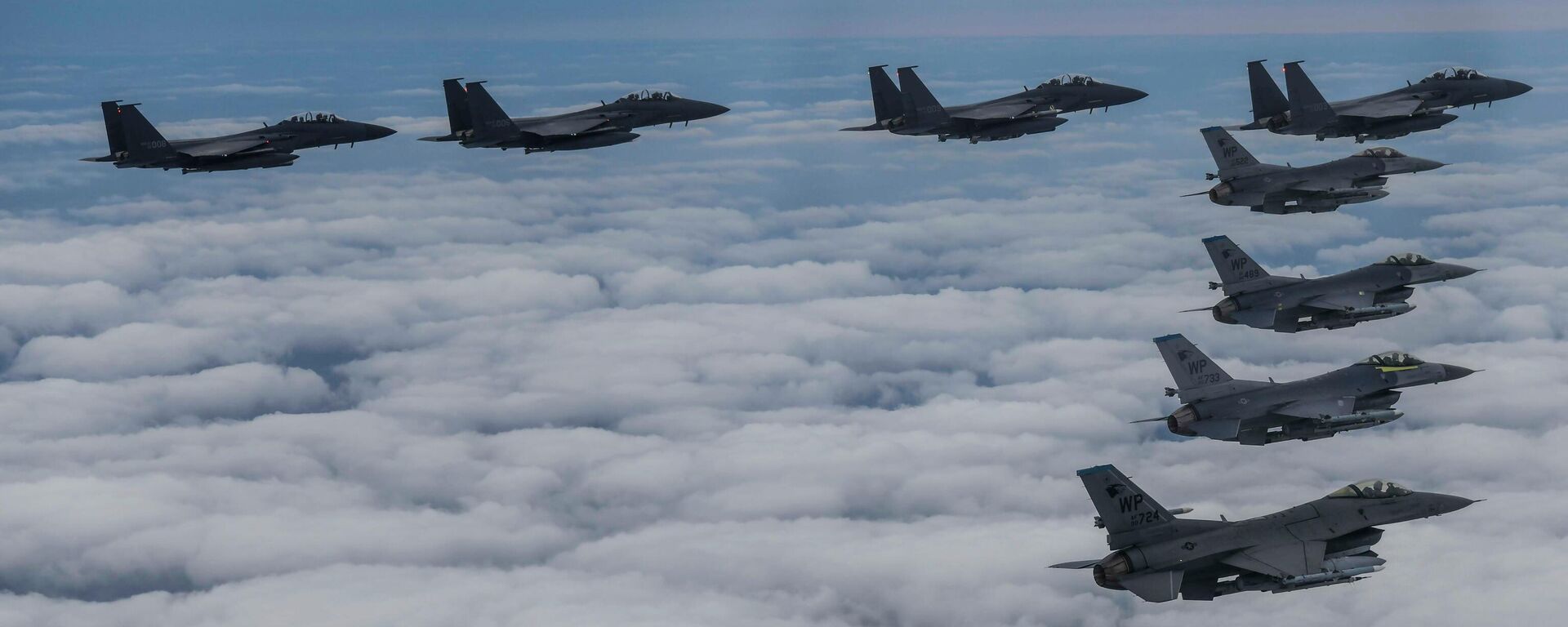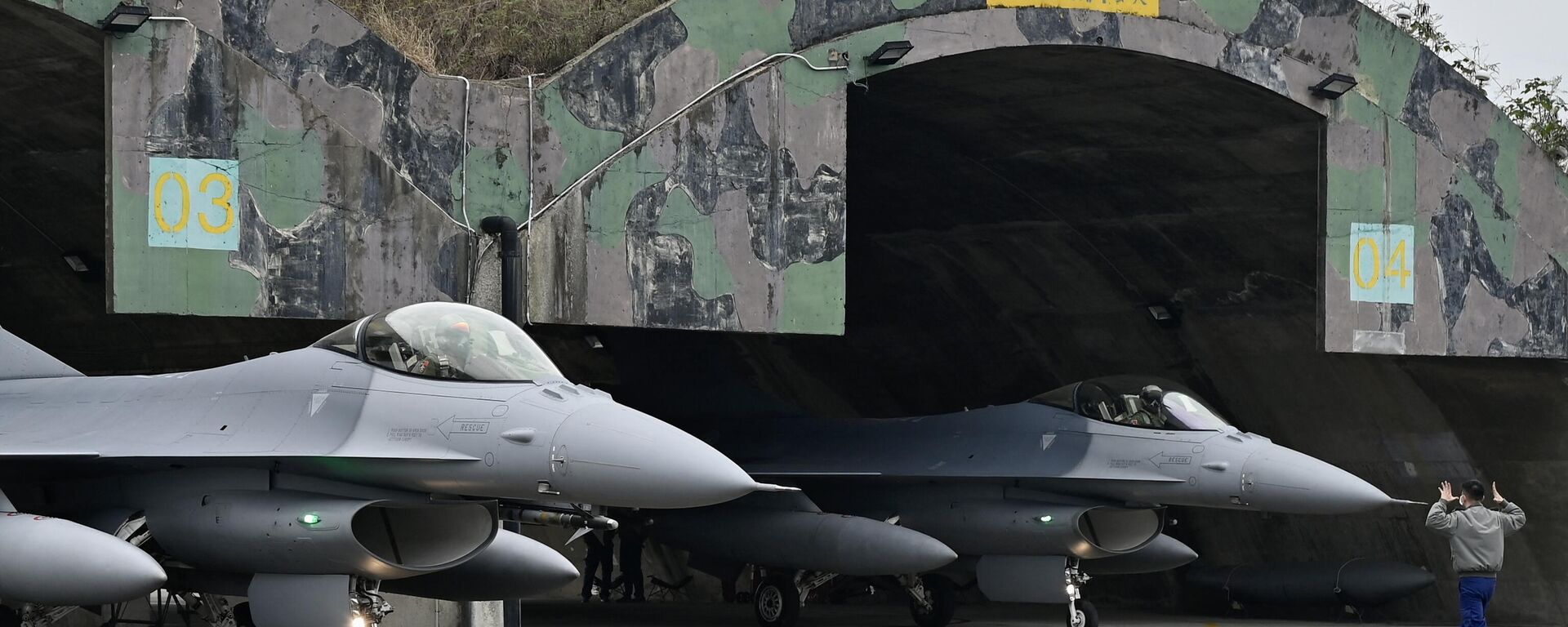https://sputnikglobe.com/20230508/japan-south-korea-rapprochement-aids-us-pacific-policy-vs-china-and-dprk-1110192587.html
Japan-South Korea Rapprochement Aids US Pacific Policy vs China and DPRK
Japan-South Korea Rapprochement Aids US Pacific Policy vs China and DPRK
Sputnik International
While South Korea and officially-peaceful Japan and only mid-level powers in the Pacific, closer ties between the two could be part of US-led militarisation of the region as part of its geo-strategic plans.
2023-05-08T15:49+0000
2023-05-08T15:49+0000
2023-05-08T15:49+0000
asia
japan
south korea
north korea
us
china
moon jae-in
fumio kishida
yoon suk yeol
https://cdn1.img.sputnikglobe.com/img/07e7/05/08/1110192704_0:0:3012:1694_1920x0_80_0_0_980e53d74b8d91df29ecc2b18d7e783c.jpg
Newly improved relations between Tokyo and Seoul will aid Washington's plan to control the Asia-Pacific region as part of a new Cold War with China and North Korea.South Korean President Yoon Suk-yeol and Japanese Prime Minister Fumio Kishida met in the Seoul over the weekend along with ministers from both governments.But the main beneficiary of closer ties between the two countries may be the US, as it strives to forge a regional military alliance along the lines of NATO against its main economic rival China and the Democratic People's Republic of Korea (DPRK), increasingly defiant of US hegemony.Ongoing DisputesBehind the smiles for the cameras at the summit, relations between the two US allies are clouded by more than one issue. Imperial Japan conquered Korea in 1910 and was not expelled until the end of the Second World War in 1945. Tokyo has for years resisted paying reparations to Koreans used as forced labour during that period, including young women and girls as young as 12 taken as sex slaves for Japanese soldiers.The Japanese PM's visit also sparked protests over plans to dump 1.3 million tonnes of radioactively-contaminated cooling water from the crippled Fukushima nuclear power plant into the Pacific ocean, ignoring the concerns of neighbouring countries.Regional Power StruggleUnder hard-line conservative President Yoon, the Republic of Korea (RoK) has ended the détente with the DPRK that flourished under his more liberal predecessor Moon Jae-in during the administration of former US president Donald Trump.He has re-instituted the bi-annual joint wargames with US forces near the Demilitarized Zone, which Pyongyang regards as barely-concealed deployments for an invasion. The north has in return resumed tests of missiles capable of hitting the south, Japan and the mainland US, not to mention the UK and France.Last week, Yoon's national security advisor Kim Tae-hyo said South Korea was moving towards "sharing nuclear weapons with the US" — hinting at a return to Washington basing its strategic weapons in the country as a threat not only to the north but to China and Russia too.But more significantly, Japan continues its slow departure from the principle enshrined in its post-war constitution of non-militarism and armament solely for national self-defence, with increased spending on the armed forces following previous legialation to allow troops to be deployed overseas. Japanese ships and aircraft joined in with US-South Korean exercises in April.China, however, remains the main target of US sabre-rattling in the Pacific, with the focus shifting from the South China Sea to Taiwan — over which the US and its Western allies still recognise Beijing's sovereignty under the 'one China policy'.Washington upped the ante with former House of Representatives speaker Nancy Pelosi's unannounced visit to Taipei in August 2022 — on a US Air Force jet — and her successor Kevin McCarthy's reciprocal welcome to Taiwanese President Tsai Ing-wen in April this year.The US Treasury department is ramping up sanctions on Beijing, including bans on the export of high-end microchips — many of which are made by US tech firms at factories on the Chinese mainland — in an escalation of the trade war begun by Trump.And Washington has drawn Australia, part of the 'Five Eyes' intelligence-sharing group that also includes the UK, Canada and New Zealand, into its militarisation of the Pacific with a deal to sell Canberra cruise missile-armed nuclear-powered submarines.
https://sputnikglobe.com/20230506/south-korea-us-to-launch-largest-ever-live-fire-exercises-in-may---reports-1110141657.html
https://sputnikglobe.com/20230506/us-to-reportedly-fast-track-500-mln-arms-for-taiwan-amid-narrative-of-china-threat-1110137406.html
japan
south korea
north korea
china
Sputnik International
feedback@sputniknews.com
+74956456601
MIA „Rosiya Segodnya“
2023
James Tweedie
https://cdn1.img.sputnikglobe.com/img/07e4/08/1c/1080307270_0:3:397:400_100x100_80_0_0_7777393b9b18802f2e3c5eaa9cbcc612.png
James Tweedie
https://cdn1.img.sputnikglobe.com/img/07e4/08/1c/1080307270_0:3:397:400_100x100_80_0_0_7777393b9b18802f2e3c5eaa9cbcc612.png
News
en_EN
Sputnik International
feedback@sputniknews.com
+74956456601
MIA „Rosiya Segodnya“
Sputnik International
feedback@sputniknews.com
+74956456601
MIA „Rosiya Segodnya“
James Tweedie
https://cdn1.img.sputnikglobe.com/img/07e4/08/1c/1080307270_0:3:397:400_100x100_80_0_0_7777393b9b18802f2e3c5eaa9cbcc612.png
us, japan, south korea, north korea, dprk, china, russia, pacific, taiwan, nuclear weapons, missile tests, australia.
us, japan, south korea, north korea, dprk, china, russia, pacific, taiwan, nuclear weapons, missile tests, australia.
Japan-South Korea Rapprochement Aids US Pacific Policy vs China and DPRK
While South Korea and officially-peaceful Japan and only mid-level powers in the Pacific, closer ties between the two could be part of US-led militarisation of the region as part of its geo-strategic plans.
Newly improved relations between Tokyo and Seoul will aid Washington's plan to control the Asia-Pacific region as part of a new Cold War with China and North Korea.
South Korean President Yoon Suk-yeol and Japanese Prime Minister Fumio Kishida met in the Seoul over the weekend along with ministers from both governments.
"It is significant that shuttle diplomacy between the leaders of Korea and Japan is now in full swing," Yoon said following talks on Sunday.
But the main beneficiary of closer ties between the two countries may be the US, as it strives to forge a regional military alliance along the lines of
NATO against its main economic rival China and the Democratic People's Republic of Korea (DPRK), increasingly defiant of US hegemony.
Behind the smiles for the cameras at the summit, relations between the two US allies are clouded by more than one issue.
Imperial Japan conquered Korea in 1910 and was not expelled until the end of the Second World War in 1945. Tokyo has for years resisted paying reparations to Koreans used as forced labour during that period, including young women and girls as young as 12 taken as sex slaves for Japanese soldiers.
"I myself feel pain in my heart that many people suffered pain and sadness in the very tough environment," Kishida told reporters alongside Yoon following the summit. "It's my responsibility as prime minister of Japan to cooperate with President Yoon and South Korea for the future, continuing our predecessors’ efforts to overcome difficult periods."
The Japanese PM's visit also sparked protests over plans to dump 1.3 million tonnes of
radioactively-contaminated cooling water from the crippled Fukushima nuclear power plant into the Pacific ocean, ignoring the concerns of neighbouring countries.
Under hard-line conservative President Yoon, the Republic of Korea (RoK) has ended the détente with the DPRK that flourished under his more liberal predecessor Moon Jae-in during the administration of former US president
Donald Trump.He has re-instituted the bi-annual joint wargames with US forces near the Demilitarized Zone, which Pyongyang regards as barely-concealed deployments for an invasion. The north has in return resumed tests of missiles capable of hitting the south, Japan and the mainland US, not to mention the UK and France.
Last week, Yoon's national security advisor Kim Tae-hyo said South Korea was moving towards
"sharing nuclear weapons with the US" — hinting at a return to Washington basing its strategic weapons in the country as a threat not only to the north but to China and Russia too.
But more significantly, Japan continues its slow departure from the principle enshrined in its post-war constitution of non-militarism and armament solely for national self-defence, with
increased spending on the armed forces following previous legialation to allow troops to be deployed overseas. Japanese ships and aircraft joined in with US-South Korean exercises in April.
China, however, remains the main target of US sabre-rattling in the Pacific, with the focus shifting from the South China Sea to Taiwan — over which the US and its Western allies still recognise Beijing's sovereignty under the 'one China policy'.
Washington upped the ante with former House of Representatives speaker Nancy Pelosi's unannounced visit to Taipei in August 2022 — on a US Air Force jet — and her successor Kevin McCarthy's reciprocal welcome to Taiwanese President Tsai Ing-wen in April this year.
The US Treasury department is ramping up sanctions on Beijing, including bans on the export of high-end microchips — many of which are made by US tech firms at factories on the Chinese mainland — in an escalation of the trade war begun by Trump.
And Washington has drawn Australia, part of the 'Five Eyes' intelligence-sharing group that also includes the UK, Canada and New Zealand, into its militarisation of the Pacific with a deal to sell Canberra cruise missile-armed
nuclear-powered submarines.






